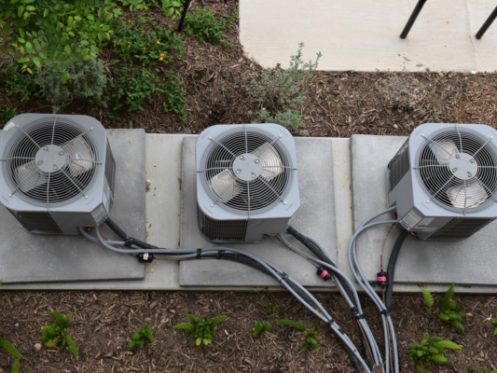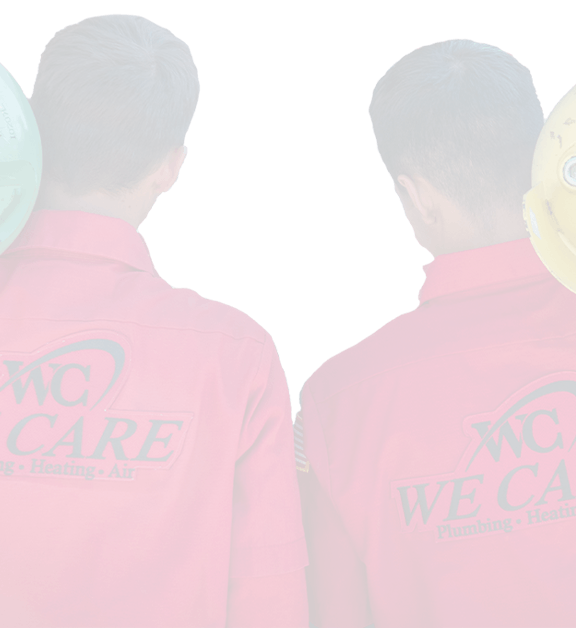The term “heat pump” is a bit misleading, since a heat pump does more than heat—it also cools. In fact, today’s heat pumps can offer heating, cooling, air purification, and dehumidification—all in one unit. At its core, a heat pump controls the temperature in your home by redistributing heat that’s in the air already.
A great replacement for most conventional HVAC systems, a heat pump keeps your home warm in the cold months and cool in the warm months. Its name derives from the fact that no matter the season, its job is to pump (and redistribute) heat or air to be heated. From a very rudimentary point of view, in the winter months, a heat pump extract heat from outdoors and moves it inside the home. In the summer months, the process is simply reversed, with the heat pump pumping heat from inside the home to the outdoors. With a heat pump you get year-round climate control for a more comfortable home.
A conventional heat pump distributes heated or cooled air through the home’s ductwork. This type of heat pump is sometimes referred to as a standard-split system.
The Mechanics Behind Heat Pumps
Although there are several types of heat pumps, each of them essentially does one thing – transfer heat. And instead of creating heat through the combustion of fuel, the heat pump works by moving heat from one area to another through a reversal of the natural flow of heat from an area of high temperatures to an area of low temperatures, which is known as thermodynamics.
Heat pumps use a small amount of energy to pull heat from an area with lower temperatures and pump it to an area of higher temperatures. The source of the heat is usually the air but can be the ground in some heat pump models.
For example, if you have an air-source heat pump, which is among the most common, then the unit pulls heat from the outside air, pumps it in via coils filled with refrigerant, sort of like the technology that keeps the food inside your refrigerator nice and cool. Inside the heat pump lies refrigerant-filled coils, two fans, a compressor, and a reversing valve. Most have two components, including an indoor air handler and an outdoor condensing unit that looks very much like a traditional central AC unit.
An air-source heat pump’s magic relies on its reversing valve being cool. The reversing valve allows for the change in refrigerant flow through the system, which essentially facilitates the reversal of the thermodynamic process. The result is that the heat pump absorbs indoor heat, pumps it outdoors, and as air comes back into the home, the refrigerant cools it down. The process continues on a loop until your home’s desired interior temperature is reached.
The technology behind heat pumps is nothing new, although it has advanced quite a bit since the first heat pumps were released. From some aspects, a traditional AC unit is a lot like a heat pump, since both a conventional unit and a heat pump both work by removing heat from the home and redistributing it outdoors. The biggest difference lies in the heat pump’s ability to also transfer heat into the home, allowing it to be a great and more energy-efficient alternative to a regular furnace or boiler.
Although less common, geothermal heat pumps are also available. These units pump heat to and from the earth or, sometimes, a source of water. This technology was developed on the principle that ground and water temperatures around the home are relatively constant. This type of heat pump is quite pricey and requires excavation for installation (and any subsequent repairs and service), so it’s not common to see one installed in a residential home.
Ducted or Ductless?
Heat pumps are available in both ducted (traditional) models and ductless models, which are sometimes called mini splits or ductless mini splits. The biggest difference between a conventional, ducted heat pump and a ductless unit is the method that air is handled inside the house.
A ductless heat pump unit makes use of compact units that mount on the wall. These units are known as mini splits, and their job is to distribute the air. As the name suggests, ductless units require no ductwork, which makes them ideal for use in homes where installing ductwork is prohibited either structurally or financially. Multiple air handlers can be placed throughout the home at strategic points to make sure that every room or area of the home is adequately heated or cooled.
Advantages of Heat Pumps
Heat pump installation has its perks. Some of the standout reasons to consider heat pump installation include these benefits:
One unit replaces an entire HVAC system
You don’t need to install more than one system in order to adequately control your home’s temperature.
Energy savings
Because heat pumps redistribute heat that already exists in the environment, the process of operating a heat pump requires less energy than that of a conventional HVAC system. The U.S. Department of Energy notes that switching to a heat pump in lieu of a traditional furnace or baseboard heaters can reduce homeowners’ energy costs by as much as half.
Versatile Installation
With mini-splits and ductless systems, you can add heating and cooling to rooms and spaces that are normally hard to access.
Reliable Comfort
A heat pump is a big upgrade to a standard furnace, and using a heat pump to control your home’s temperature makes your indoor climate easier to control. Heating and cooling become more reliable. Continuous airflow throughout the home means that it’s just as comfy in one room as it is in another. And if you go for a ductless mini split setup, you can adjust the temperature in different areas to suit different needs.
Greener Air
Today’s heat pumps offer the cleanest, greenest energy available. Unlike systems powered by natural gas or oil, heat pumps are totally powered by electricity. This reduces the carbon dioxide output for your entire household. And because heat pumps are very energy-efficient, you burn less electricity over the use of other heating and cooling methods.
Better Air Quality
Many of the heat pumps available today have on-board air filtration systems that remove particulates and allergens from the air. This can be a godsend for household members who have allergies or respiratory conditions.
Fuss-free Ownership
Unlike a conventional HVAC made of different components, a heat pump is easy to own. Most heat pumps offer quiet operation and they don’t produce any weird odors. What’s more, maintenance for heat pumps is minimal and mainly involves keeping the filter clean and clearing away any debris such as leaves that might accumulate around the outdoor condensing unit. You’ll also want to schedule seasonal maintenance for your heat pump to make sure it’s in perfect running shape for both hot and cold weather.
A Great Investment
Because you stand to shave a load of cash off your energy bill when you install a heat pump, this type of HVAC system is a great investment that will literally pay for itself over time.
Heat Pumps Near You
If you’re in need of a heat pump and you live in the Southern California area, we’re happy to assist you! Reach out to our team at We Care Plumbing, Heating and Air now to learn more about heat pump installation and how it can work for you. Our technicians are professional, knowledgeable, and eager to help!







